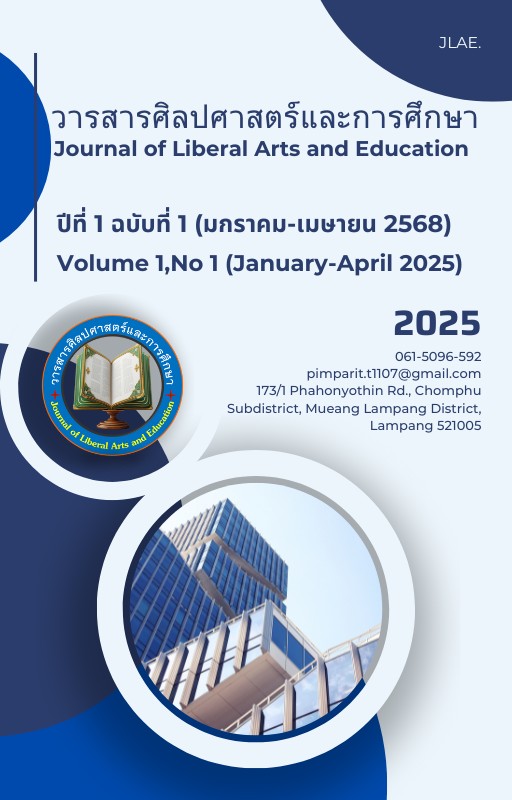A Study and Comparison of Learning Organization of Schools the Secondary Educational Service Area Office Surin
Keywords:
Learning Organization, Learning Dynamics, Organizational Transformation, Knowledge ManagementAbstract
Research on A Study and Comparison of Learning Organization) To study being a learning organization of an educational institution under the Surin Secondary Education Service Area Office. and 2) to compare the learning organization of educational institutions. Under the Surin Secondary Education Service Area Office classified by location Work experience and size of the school. An example in the research is School administrators and teachers, there were of 357 people , including 20 school administrators and 337 teachers , totaling 85 schools .
The results of the research showed that 1) being A Study and Comparison of Learning Organization of Schools the Secondary Educational Service Area Office Surin Overall, it was at a high level,. The aspect with the highest mean was the aspect of organizational change at a high level, followed by the learning dynamics. At a high level, next is the aspect of enhancing knowledge to people. At a high level, in knowledge management. It was at a high level, The lowest mean level of operation was the technology implementation aspect. At a high level. 2) Comparison of being A Study and Comparison of Learning Organization of Schools the Secondary Educational Service Area Office Surin Classified by position, it was found that overall and each aspect were significantly different at the .01 level. Classified by work experience, it was found that overall and each aspect was significantly different at the .01 level. And classified by school size, it was found that overall and each aspect were significantly different at the .01 level.
References
จิราพรรณ เสียงเพราะ. (2560). การเป็นองค์กรแห่งการเรียนรู้ของสถานศึกษาตามการรับรู้ของครู สังกัดสำนักงานเขตพื้นที่การศึกษามัธยมศึกษา เขต 11 ในจังหวัด สุราษฎร์ธานี.การค้นคว้าอิสระศึกษาศาสตรมหาบัณฑิต. สาขาการบริหารการศึกษา. คณะศึกษาศาสตร์. มหาวิทยาลัยราชภัฏสุราษฎร์ธานี.
พงษ์ธร หนูฤทธิ์,สุรชัย สิกขาบัณฑิต .(2563).วัฒนธรรมองค์กรของสถานศึกษาที่ส่งผลต่อการเป็น องค์กรแห่งการเรียนรู้ ในสถานศึกษา สังกัดสำนักงานเขตพื้นที่การศึกษามัธยมศึกษา
เขต 2.วารสารวิชาการมหาวิทยาลัยอีสเทิร์นเอเชีย,249-259.
ยุพมาศ สุกใส. (2556). การเป็นองค์กรแห่งการเรียนรู้ของสถานศึกษา สังกัดสำนักงานเขตพื้นที่ การศึกษามัธยมศึกษา เขต 23. วิทยานิพนธ์ครุศาสตร์อุตสาหกรรมดุษฎีบัณฑิต. สาขาวิชาการบริหารการศึกษา. คณะครุศาสตร์อุตสาหกรรม. สถาบันเทคโนโลยีพระจอมเกล้าเจ้าคุณทหารลาดกระบัง.
วัฒนสิน บุสดี. (2559). รูปแบบองค์กรแห่งการเรียนรู้ของโรงเรียนสังกัดสำนักงานเขตพื้นที่การศึกษามัธยมศึกษา เขต 19. วิทยานิพนธ์ปรัชญาดุษฎีบัณฑิต. สาขาวิชาการบริหารการศึกษา, มหาวิทยาลัยนอร์ท กรุงเทพ.
สายรุ้ง เฟื่องสินธุ์. (2556). การพัฒนาโรงเรียนให้เป็นองค์กรแห่งการเรียนรู้ ของโรงเรียนในสำนักงานเขตจอมทอง สังกัดกรุงเทพมหานคร. วิทยานิพนธ์ปริญญาครุศาสตร์มหาบัณฑิต. สาขาการบริหารการศึกษา. คณะครุศาสตร์. มหาวิทยาลัยราชภัฏธนบุรี.
สุณิชษา วินิจฉัย. (2560). พฤติกรรมการบริหารองค์กรแห่งการเรียนรู้ของผู้บริหารสถานศึกษา สังกัดสำนักงานเขตพื้นที่การศึกษามัธยมศึกษาเขต 17 จังหวัดจันทบุรี. วิทยานิพนธ์การศึกษามหาบัณฑิต. สาขาวิชาการบริหารการศึกษา. คณะศึกษาศาสตร์. มหาวิทยาลัยบูรพา.
สำนักงานเขตพื้นที่การศึกษามัธยมศึกษาสุรินทร์.(กลุ่มนโยบายและแผน). (2562). แผนปฏิบัติการ
ประจำปีงบประมาณ พ.ศ.2562. สุรินทร์: สำนักงานเขตพื้นที่การศึกษามัธยมศึกษาเขต 33.
สำนักงานเขตพื้นที่การศึกษามัธยมศึกษาสุรินทร์.(กลุ่มนโยบายและแผน). (2562).(2564). แผนการพัฒนาการศึกษา พ.ศ. 2563 – 2565 สพม.33 . สุรินทร์: สำนักงานเขตพื้นที่การศึกษามัธยมศึกษา เขต 33.
สำนักงานเลขาธิการสภาการศึกษา.(2551).กรอบทิศทางการพัฒนาการศึกษา ในช่วงแผนพัฒนา เศรษฐกิจและสังคมแห่งชาติฉบับที่ 10 (พ.ศ.2550-2554) ที่สอดคล้องกับแผนการศึกษาแห่งชาติ (พ.ศ.2545-2559) ฉบับสรุป.กรุงเทพฯ:วี.ที.ซี. คอมมิวนิเคชั่น.
Krejcie, R. V. & Morgan, D. W.(1970). Determining Sample Size for Research Activities. Educational and Psychological Measurement, 30(3), pp. 607-610.
Marquardt, M.J. (2002). Building the Learning Organization: A Systems Approach to Quantum Improvement and Global Success. New York: McGraw-Hill.
Downloads
Published
How to Cite
Issue
Section
License

This work is licensed under a Creative Commons Attribution-NonCommercial-NoDerivatives 4.0 International License.
This article is published under a Creative Commons Attribution-NonCommercial-NoDerivatives 4.0 International License (CC BY-NC-ND 4.0), which allows others to share the article with proper attribution to the authors and prohibits commercial use or modification. For any other reuse or republication, permission from the journal and the authors is required.

